
Sir Edwin Landseer Lutyens was an English architect known for imaginatively adapting traditional architectural styles to the requirements of his era. He designed many English country houses, war memorials and public buildings. In his biography, the writer Christopher Hussey wrote, "In his lifetime (Lutyens) was widely held to be our greatest architect since Wren if not, as many maintained, his superior". The architectural historian Gavin Stamp described him as "surely the greatest British architect of the twentieth century".
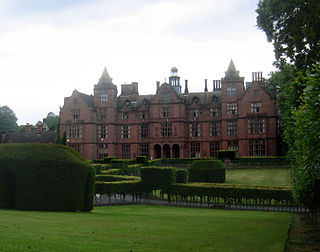
Hewell Grange is a country house in Tardebigge, Worcestershire, England. "One of the most important late 19th century country houses in England", the mansion was built in 1884-91 by George Frederick Bodley and Thomas Garner for the Earl of Plymouth. Constructed in the Jacobethan style, it was "perhaps the last Victorian prodigy house." It is a Grade II* listed building. The park had been developed round an earlier house on the site by both Capability Brown and Humphry Repton and is on the National Register of Historic Parks and Gardens. The lake is a Site of Special Scientific Interest(SSSI).
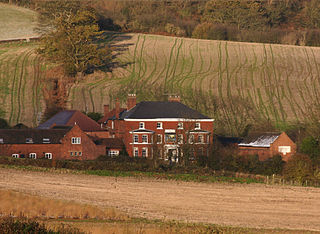
Great Witley is a village and civil parish, in the Malvern Hills District in the northwest of the county of Worcestershire, England. It is situated around ten miles to the north west of the city of Worcester.

Elsham Hall is a 17th-century English country house situated in its own parkland in Elsham, North Lincolnshire. The park and gardens are open to the public.

Baddiley is a scattered settlement and civil parish in the unitary authority of Cheshire East and the ceremonial county of Cheshire, England. The civil parish also includes the north-western part of the village of Ravensmoor, as well as the small settlements of Baddiley Hulse, Batterley Hill, and parts of Gradeley Green and Swanley. According to the 2001 Census the parish had a total population of 226, increasing at the 2011 Census to 249.
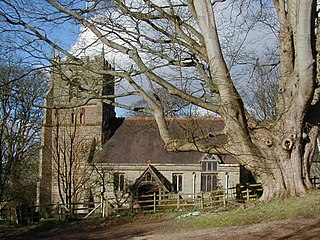
Beoley is a small village and larger civil parish north of Redditch in the Bromsgrove District of Worcestershire. It adjoins Warwickshire to the east. The 2001 census gave a parish population of 945, mostly at Holt End. The parish includes the hamlet of Portway, adjacent to the A435 road. It adjoins the Redditch suburb of Church Hill and the civil parishes of Alvechurch, Tanworth-in-Arden, Mappleborough Green and Wythall.
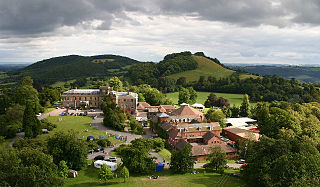
Abberley Hall is a country house in the north-west of the county of Worcestershire, England. The present Italianate house is the work of Samuel Daukes and dates from 1846–49. Since 1916 it has been occupied by Abberley Hall School. It is a Grade II* listed building. The gardens are listed as Grade II on the English Heritage Register of Parks and Gardens of Special Historic Interest in England. In the area close to Stourport-on-Severn there are several large manor and country houses, among which Witley Court, Astley Hall, Pool House, Areley Hall, Hartlebury and Abberley Hall are particularly significant.
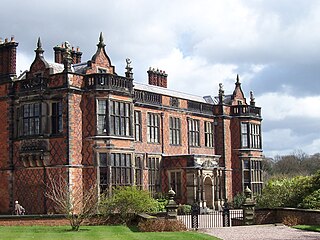
Arley Hall is a country house in the village of Arley, Cheshire, England, about 4 miles (6 km) south of Lymm and 5 miles (8 km) north of Northwich. It is home to the owner, Viscount Ashbrook, and his family. The house is a Grade II* listed building, as is its adjacent chapel. Formal gardens to the southwest of the hall are also listed as Grade II* on the National Register of Historic Parks and Gardens. In the grounds are more listed buildings, a cruck barn being listed as Grade I, and the other buildings as Grade II.

Mellor Hall is a country hall in Mellor, Greater Manchester, England, 0.4 miles (0.64 km) north of The Devonshire Arms off Longhurst Lane.
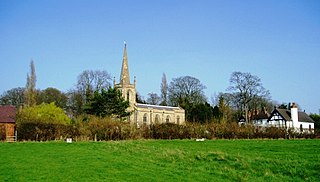
Stone is a village and civil parish in the Wyre Forest District of Worcestershire, England. Of Anglo-Saxon origin, it lies two miles south-east of Kidderminster on the A448 road to Bromsgrove.
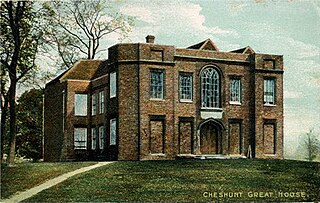
Cheshunt Great House was a manor house in the town of Cheshunt, Hertfordshire, England, near to Waltham Abbey. It is said to have been built by Henry VIII of England for Cardinal Thomas Wolsey. The family seat of the Shaw family for over a century, by the late 19th century it was used as a Freemasons Hall and was later used during World War II. After the war, the hall was too costly to run and was opened to the public until a fire gutted it in 1965. It was made a Grade II listed building on 11 June 1954.

Poole Hall is a Regency mansion at Poole, near Nantwich in Cheshire, England. It dates from 1812–17 and is recorded in the National Heritage List for England as a designated Grade II* listed building. Nikolaus Pevsner considered the interior to be "exceptionally fine". The hall is a private residence and is not open to the public.

Caerhays Castle or Carhayes Castle is a semi-castellated manor house 0.5 mi (0.80 km) south of the village centre, St Michael Caerhays, Cornwall, England, UK. It overlooks Porthluney Cove on the English Channel. The garden hosts the largest collection of magnolias in the United Kingdom and contains one of four National Magnolia Collections under the auspices of the National Council for the Conservation of Plants and Gardens.

Rode Hall, a Georgian country house, is the seat of the Wilbraham family, members of the landed gentry in the parish of Odd Rode, Cheshire, England. The estate, with the original timber-framed manor house, was purchased by the Wilbrahams from the ancient Rode family in 1669. The medieval manor house was replaced between 1700 and 1708 by a brick-built seven-bay building; a second building, with five bays, was built in 1752; the two buildings being joined together in 1800 to form the present Rode Hall.
Tattenhall Hall is a country house standing to the south of the village of Tattenhall, Cheshire, England. The house is designated by English Heritage as a Grade II* listed building.
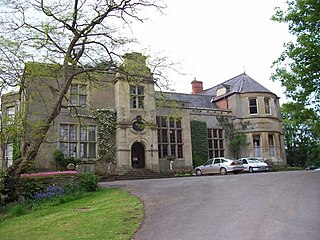
Burton Court is a Grade II* listed English country manor house in the Parish of Eardisland, southwest of Leominster, Herefordshire, England. The manor dates to at least the 11th century and the current house to the early 14th and 18th century. It lies along the A44 road, about 1 mile (1.6 km) south of Eardisland in the northern part of the hamlet of Lower Burton. It is now run as a Herefordshire wedding and private hire venue. Burton Court featured in Simon Jenkins's book England's Thousand Best Houses.

Woodford is a civil parish in southern-central Wiltshire, England, on the west bank of the Salisbury Avon, about 4 miles (6 km) north of Salisbury. Its settlements are the villages of Lower Woodford, Middle Woodford and Upper Woodford, the last of which is the largest of the three. In 1871, the population was 523; in 1951, this had decreased to 405 people.

Gaulden Manor is a Grade II* listed country house to the southeast of Tolland, Somerset, England. It is a double storied building with interior plasterwork, as well as a garden consisting of herbs, old roses and a pond. A room referred to as a chapel has a c.1640 ceiling featuring an angel with trumpet on Judgment Day.

Gledstone Hall is a 20th-century country house in West Marton, near Skipton, North Yorkshire. Designed by Edwin Lutyens it stands in a 12 hectare estate. It is a Grade II* listed building. The gardens are separately listed Grade II.

Westwood House is a stately home, near Droitwich, Worcestershire, England. It has been subdivided into twelve self-contained apartments. The house has origins as an Elizabethan banqueting hall with Caroline additions and is a Grade I listed building. It was for several centuries the seat of the Pakington family. Situated west of Droitwich, it lies in the centre of its former estate, Westwood Park, which is Grade II listed in the National Register of Historic Parks and Gardens.




















